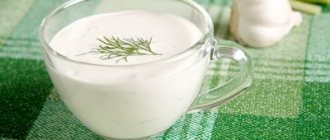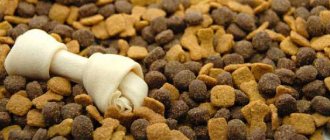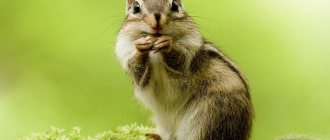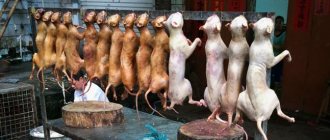Saint Bernard is a breed with an interesting and eventful history. In order for the clumsy lump to grow into a healthy and proud dog, special attention should be paid to its nutrition.
Regardless of the type of feeding, a St. Bernard puppy should always have access to drinking water. Change the water at least once a day or more often if it becomes dirty quickly.
Saint Bernards are fed from special stands. With age, the level at which the bowl is located increases. The main rule is that while eating, the dog’s head remains level with the back. If this rule is not followed, the animal’s posture is disrupted and health problems may arise in the future.
When buying a St. Bernard puppy, it is better to immediately buy a large bowl. As they grow, a larger bowl is required, which matters not so much because of the amount of food, but because of the size of the dog’s head. It will simply be inconvenient for her to eat from a small bowl.
Dogs should not be given cold or hot food. Food should be at room temperature or slightly warmer.
The owner himself chooses the type of feeding the St. Bernard puppy - ready-made food or natural food. But before drawing up a menu, it is necessary to clarify what the former owner fed him, and gradually, over the course of 1-2 weeks, transfer him to the diet that was personally chosen. A sudden change in food leads to digestive problems, especially at an early age.
How to properly feed a St. Bernard with natural products
Saint Bernards are carnivores and require large amounts of protein food every day. For example, during the period of feeding a puppy, you need to stock up on natural products: milk, cottage cheese, minced beef, chicken eggs. Feeding adults requires meat and meat by-products, which must be given on an ongoing basis.
Important: a dog should not be underfed or overfed at any stage of its life!
Proper feeding of a St. Bernard does not mean that expensive means healthy. There were owners who fed their large pets fresh beef purchased at the market. There is nothing wrong with such an expensive meal of beef tenderloin, of course, except for the expense. By approaching it wisely and with calculation, feeding a St. Bernard can be made cheaper without harming your pet. You should consider slaughter products, which can be purchased from any agricultural farm.
Products that are harmful or useless for dogs:
- Mushrooms.
- Corn.
- Potato.
- Pasta.
- Pearl barley.
- Sugar, salt, spices.
- Smoked products.
- Very fatty meat, lard.
- Legumes - soy products, peas, beans.
Important: tubular bones of birds and small animals are deadly for dogs!
Basic rules for feeding puppies:
- Puppies definitely need high-quality mineral supplements and vitamins.
- Food should be fresh and slightly warm. The consistency of a very thick soup.
- Get used to new types of foods gradually.
- If a puppy or an adult dog leaves something in the bowl after eating, then you need to reduce the portion.
- If everything has been eaten and the pet diligently licks the bowl, then it’s time to increase the portion.
- Meat products should be fed fresh.
- Sea fish is given to a grown-up St. Bernard raw (if the fish is freshly caught or from the river, always cook it.)
- Be sure to clean the bowl after feeding.
- Provide constant access to clean, fresh water.
Exercise stress
Saint Bernards are a hardy and physically active breed; they are suitable for long walks and active games like agility .
But you shouldn't be overzealous. Due to their large size, St. Bernards are more suitable for walking or slow running and quiet games.
Saint Bernards love to swim
When the St. Bernard puppy is tired enough after a walk and well fed, he can calmly wait for his owner.
But he should leave a few toys so that he has something to occupy himself with.
Even at home, you need to play with animals (especially small ones) so that their activity is directed in a positive direction, while unobtrusively training and explaining the rules of behavior.
St. Bernard puppies require great care when handling.
You can’t lift them by their front legs - you can dislocate their joints, and in general you shouldn’t carry them around often.
If you need to lift your baby, support him under the chest and under the buttocks, and when lowering him back to the floor, make sure that all four paws are on the floor, and only then remove your hands.
A dog that has walked enough and is tired will behave well at home.
A St. Bernard puppy can easily injure ligaments if it jumps from a height greater than its height. Running is better for this breed than jumping.
Daily diet for a puppy: list of products and calculation of food volume
The future champion needs to be fed properly.
The basis of feeding puppies is the main component of 3/4 of the diet - products of animal origin (necessarily boiled). The rest is boiled cereal (buckwheat, rice or wheat), which makes up 1/4 of the total daily food intake.
It is more convenient to cook porridge once and for several days. It needs to be stored in the refrigerator, which can be fed to the puppies at any time, diluting it with warm broth or kefir. Dilute cottage cheese with kefir, fermented baked milk, yogurt, and alternate fish and meat days. The total amount of food will be 7% of the baby’s weight - this is how you need to calculate the entire time of raising a St. Bernard up to 7 months. We don’t take into account the weight of the broth and kefir!
For example: the weight of a St. Bernard puppy is 5 kg, which means the daily volume of food is 350 grams + broth or kefir, vitamins. To feed a St. Bernard puppy, there is a list of products that are necessary for the full development of the body.
Consider the list of products included in the diet of puppies:
- Cereals - rice, buckwheat, wheat groats, oatmeal.
- Meat - beef, chicken, horse meat, rabbit, turkey, lean pork and lamb.
- Liver - liver, heart, lung, kidneys.
- Sea fish - pink salmon, chum salmon, navaga, flounder, perch.
- Fermented milk products - cottage cheese, milk.
- Chicken egg.
When boiling broth on fresh animal bones, you do not need to feed the bones themselves, they clog the intestines. For proper growth of the puppy, it is necessary to add additional micronutrient complexes to the diet, containing calcium and phosphorus in proportions of 2 to 1, vitamins (A, D, E) are also necessary.
Age 1.5 months
At the age of 1.5 months, the number of feedings is 6 times a day. No need to weigh every gram of food. It is enough to adhere to the proportions - 1/4 boiled porridge + 3/4 finely chopped meat or (minced meat, sea fish fillet, cottage cheese, offal). When combining the ingredients, divide them into 6 parts - this will be a complete diet for one day for a puppy from one and a half months. Weigh your pet and determine the daily food intake.
For example: the baby’s weight is 6 kilograms, which means that 7% of his weight will be 420 grams - this will be the daily weight of the products. Boiled porridge – 105 grams. Meat ingredients – 315 grams + complex of minerals, vitamins, broth, kefir. We select and distribute ingredients for 6 feedings.
What does feeding look like:
- 8:00 – cottage cheese 70 gr. + kefir, fermented baked milk or yogurt + mineral complex and vitamins according to instructions.
- 11:00 – 35 gr. boiled cereal + 35 grams of minced meat + broth, mix everything until the consistency of thick soup.
- 14:00 – 70 grams of boiled liver, finely chopped and diluted with broth.
- 16:00 – 35 gr. cereal porridge + 35 gr. minced meat, diluted with broth.
- 19:00 – 35 gr. boiled cereal + 35 gr. minced meat, mix with broth.
- 23:00 – minced meat or finely chopped meat – 70 gr. + mineral supplements, vitamins according to instructions.
On fish days, add boiled fish fillet to the porridge instead of meat. For dinner, fish cut into pieces. Add a chicken egg 2 times a week on fish days.
Saint Bernards grow very quickly, every day, significantly gaining weight. When raising a puppy, you need to rely not only on calculations, but also on common sense. If the puppy licks the bowl for a long time, then he needs to be given a supplement, but if the food remains in the bowl, then the portion size should be reduced.
Age 2 months
At the age of two months, it is permissible to transfer a St. Bernard to 5 meals a day. The average food intake for a puppy weighing 8 kg will be equal to 7% of the pet’s total weight, that is, 560 grams of food per day. By the age of two months, it is better to replace the minced meat with finely chopped meat.
It is recommended at this age to accustom puppies to raw meat and sea fish. Chicken necks, backs, sea bass, navaga and any red fish are perfect. Remove only the gills and entrails, leave the ridges, fins, and heads. Very quickly the little St. Bernard will learn to cope well with such bones. We must remember that each growing organism grows and develops individually.
At the age of two months, a pet can reach a weight of 10 kilograms or more. While it's easy to weigh your baby, don't miss this opportunity to figure out how his weight matches his daily food intake.
Age 3 months
At this age, it is permissible to feed a St. Bernard 4 times a day. Do not forget to increase the mineral supplement and vitamins you have chosen according to the instructions. We maintain the principle of feeding, porridge - 1/4 of the total volume of protein food of animal origin.
It is important that the puppies themselves can handle chicken necks, backs, heads, and fresh fish carcasses. Thus, they learn to chew soft bones, receiving additional microelements naturally.
At 3 months, a crucial period begins in raising a St. Bernard - the teeth change begins. This process places an additional burden on the body. The consumption of microelements increases significantly. If you compare a kilogram of meat pulp and a kilogram of chicken backs or necks, heads, they are several times more beneficial for a puppy, as they contain a large amount of calcium.
You can give your pet a large donkey as a toy.
Let's say your baby weighs 14 kg at the age of 3 months. This means that 7% of its weight will be 980 grams - this will be the approximate daily requirement for feeding a St. Bernard. Porridge 245 grams. Meat, offal, fish, cottage cheese - 735 grams. If you really want to increase the serving size, then it is always better to give meat or fish food.
Age 4 months
The number of feedings 3-4 times a day is based on the weight of the pet and check the weight of the daily diet. In addition to porridge, the diet should contain bones and cartilage, as they contain calcium, which is necessary for the formation and growth of the skeleton.
A normally developing St. Bernard puppy at 4 months looks long-legged with exorbitantly long ears. The paws are long and straight, the toes are collected. If you run your palm over the side of the chest, the ribs can be easily felt, but do not stick out.
If you don’t have enough experience, be sure to show your baby to a kennel club. Or write questions in comments or email.
Age 5 months
It is acceptable to feed 3 times a day. Maintain the percentage of porridge and products containing natural animal protein. Several front incisors should already be replaced by permanent teeth.
Let's assume the puppy's weight at 5 months is 25 kg. - 7% of this value will be - 1 kg. 750 gr.
- 9.00 - porridge -220 gr. + 320 grams of meat, offal or boiled fish.
- 15.00 – porridge – 215 gr. + 350 meat, offal or boiled fish + mineral supplements according to instructions.
- 21.00 – 650 gr. meat by-products or fresh sea fish 800 gr. (a little more fish won't hurt)
Age 6 months
When compiling a diet for six months of age, it is quite possible to focus on the ratio of boiled porridge and meat or fish products. And also on the pet’s behavior and appetite.
The number of feedings per day is at least 3 times. Boiled cereals make up 1/4 of the total food volume. The main food is various offal, sea fish, etc.
If desired, you can grate fresh carrots with a teaspoon of vegetable oil into the porridge. Stew and add zucchini and pumpkin to your diet. This will increase the volume of fiber, which has a beneficial effect on intestinal function.
Some St. Bernard puppies continue to grow rapidly at this age. You should focus on the appearance of your pet. He should move normally, play and have an excellent appetite. But at the same time he looks like a lanky teenager.
Age 7 months
At this age, the change in the dental system ends. Please note that we continue to introduce mineral supplements and vitamins into the diet according to the instructions. At this stage of the puppy's growth, the stomachs of cattle can be connected. Tripe, mesh, and book are very useful products for carnivores. Tripe can be purchased at farmers' markets or at slaughterhouses.
Calculation and percentage of cereal and protein foods without changes: 7% of the total mass.
Dogs are physiologically no different from their wild relatives of the canine family. Foxes or wolves eat their prey completely, including skin and fur, leaving only very large bones. And the first thing wild relatives eat is the contents of the abdominal cavity. Think about it and draw your own conclusions.
Age 8 months
We feed the dog 2 times a day - morning and evening. Boiled porridge 1/3, the rest offal, sea fish. Reduce microelements, vitamins according to instructions. The average weight of puppies at this age is from 45 to 50 kg.
A healthy puppy is active and cheerful and has a good appetite. If you have the opportunity to weigh it, then base the weight ratio of the daily food intake on the basis of the ratio of 6% of the dog’s weight.
Age 9-12 months
It is enough to feed twice a day. Pay attention to the puppy's condition. Part of the porridge is vegetables, 1/3 of the total daily food intake. By-products = 2\3. Approximate diet for a St. Bernard puppy weighing 50 kg. 6% from 50 kg. equals 3 kg, this is the total daily amount of food for feeding.
- 00 – porridge in broth with vegetables 950 gr. Vegetables 50 gr. (dilute with meat broth, fermented baked milk, kefir to the consistency of thick soup). Add 500 grams of boiled meat or cottage cheese.
- meat by-products 1.5 kg. (rumen, ears, muzzles of ruminants, etc.)
At 11-12 months, active growth ends, and the St. Bernard puppy begins to gain muscle mass. The dog increases in size and gains weight. Surely you have already gotten used to cooking for your pet. You know his appetites and daily food intake, focusing on formulas for calculating the amount of food for feeding.
What to feed an adult St. Bernard
After a year, the St. Bernard's diet is close to the feeding standards of an adult dog. When feeding natural food, you must adhere to the basic rule.
- Up to one and a half years, 5% of the dog’s weight.
- Meat products – 70%. (protein food)
- Cereals and grains 20%.
- Vegetables 10%.
- A few drops of vitamins, according to the instructions.
How much your St. Bernard should eat can only be determined after weighing your pet. The height at the withers and the weight of an adult dog should have almost equal numerical values. That is, with a height of 75 cm, the weight is approximately 75 kg. The volume of an adult dog’s diet is calculated from 4% of the animal’s weight. A Saint Bernard at the age of 2 years is considered an adult.
With a weight of 75 kg, the total weight of food will be equal to three kilograms. Meat products – 40%. (protein foods) Cereals and grains 40%. Vegetables 20%. Make a menu for your dog from the natural products listed above available to you, stick to the proportions.
There is no need to try to feed the grown giant a very varied diet. The main thing is that there is a balance of protein and plant components in the St. Bernard’s diet.
Description of the breed
The main feature of the Saint Bernard dog breed is its impressive size.
- Weight about 100 kg.
- Height – 70-90 cm.
Initially, representatives of the breed weighed less and were a little more compact, which allowed them to easily climb peaks and dangerous slopes, and they began to gain weight only after the demand for decorative keeping of dogs.
Description of the breed:
- The head is large, the forehead is convex with obvious wrinkles;
- The eyes are set close together, with brown irises;
- The nose is wide, large with flat nostrils;
- Hanging, small ears;
- It has a strong build: a wide back with a steep loin, a strong chest. It has a wide, heavy tail, massive limbs, and large paws.
- The coat can be either soft or hard, but in any case it is thick.
Feeding the dog dry food
Of course, feeding a dog with ready-made food is very convenient for the owner. Additional microelements and vitamins are not required. For complete nutrition and rearing, only premium food for puppies and giant breed dogs is suitable.
Low quality food can be harmful, especially to the puppy during the growing period. Allergies to food are common. It is absolutely impossible to determine from what components dry food is made. You shouldn’t blindly trust bright packaging and the inscriptions on them.
We tried to switch the St. Bernards to dry food, but we noticed that our dogs liked tripe and natural food more. If you want to feed and raise your puppy on dry food, then use food from well-known premium brands.
Origin story
The name "Saint Bernard" comes from the place of origin of the breed - the monastery of St. Bernard in the mountains of Switzerland. Monk Bernard founded a refuge for travelers in the 11th century. The monastery, the trail and the breed of dog are named after the monk (Saint Bernard - St. Bernard). Since the monastery was located high in the mountains, where avalanches and landslides were common, they were used as rescue dogs. The rescue dog's equipment included a barrel of brandy, which was drunk by people under the snow when the dog found and dug them up.
The dog's large size, wide strong paws, thick hair, and thick skin made it a beast of burden - powerful dogs were used to carry loads in the mountains.
There is a legend that St. Bernard Barry saved more than 40 people from the snow during his life. Once he saved a boy whom he carried to the monastery for several kilometers on himself.
Read further: Large dog breeds with photos and names
When to give vitamins to puppies
Vitamins are a necessary element for the proper nutrition of the growth and development of a giant breed puppy. They should be added to the diet from the first days the puppy appears in the house.
Especially important are growth vitamins (A.D.E.), they participate in growth processes and help in the absorption of calcium. Of course, they are also found in natural products, but it is absolutely impossible to determine their quantity. It is better to add them to food, buy them at a veterinary pharmacy and follow the instructions for use.
Pros and cons of the breed
Saint Bernards certainly have many advantages, but before purchasing, all the nuances, both positive and negative, are studied.
Pros of dogs:
- Friendly;
- Good guards and defenders;
- Smart, easy to train and educate;
- Get along well with people, in particular with children;
- Find a common language with other animals.
Minuses:
- It takes a lot of effort to develop a balanced diet;
- Not suitable for apartment living;
- Frequent brushing will be required during shedding;
- Increased salivation;
- Joint diseases are common.
The ideal place for a St. Bernard to live would be private houses not in the southern regions of Russia. This will allow the dog to enjoy free walking, and the owners will not be bothered by drool and hair in the apartment.











